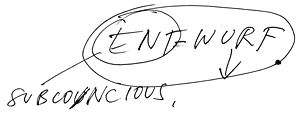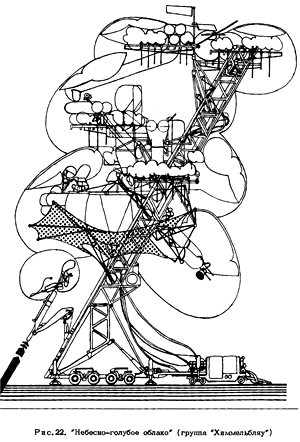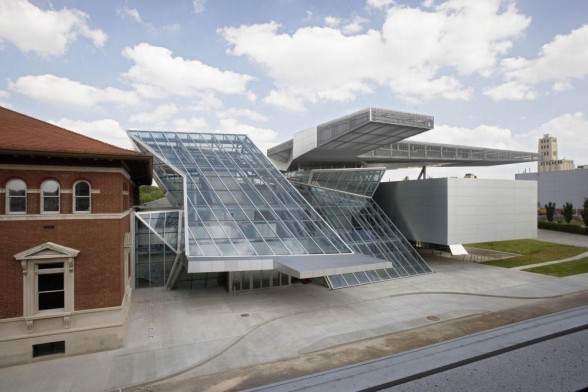via Vladimir Paperny at www.paperny.com

(Groovy D Prix)
2007
Vladimir Paperny: How did the whole idea of those futuristic projects come about? What did it mean to you?
Wolf Prix: It was in the early 60-s. I was a student, and I had a very good teacher who exposed us to the utopian world of architecture. At that time, as you know, architecture was a very rational thing, and that’s how they taught us. My father was an architect, so I knew this rational aspect of architecture really well. But, as young students, we thought there should be more to architecture than its economic aspect. In 1964 in Vienna there were already people like Hans Hollein and Günther Feuerstein, so we had role models. Especially Feuerstein, he gave us lectures on modern architecture, really contemporary architecture. He showed us all those visionary things from Corbu to Archigram. We were young and we thought we had to change architecture radically — now and on a big scale. Looking back, it was an overestimation of the willingness of politicians and the society to change. When we started we wanted to be rich and famous like Beatles or Rolling Stones. There was a lot of influence of music on our architecture. Even the name Himmelblau sounded more like a name of a rock group. Himmelblau (Blue Sky) refers to our desire to make architecture changeable like clouds.
VP: When did you add the parentheses to the name — Himmelb(l)au?
WP: When we started to build, the name changed from the Blue Sky to Building the Sky.
VP: Did you see your visionary projects as shockers? Did you take them seriously?
WP: Very seriously. Bob Dylan did not want to shock with his songs. We thought this was the way architecture should be — flexible like the clouds, reacting to the needs of the people, not rigid and cast in concrete. We were influenced more by music and utopian philosophy, than by architecture.
VP: Some of your early projects seem to refer to Tatlin’s Monument. Were you consciously making this reference?
WP: No. We were looking for role models in architecture as well as in other fields, and, of course, Russian revolutionary architecture was influencing my generation of architects, people like Zaha, Tsumi, Rem.
VP: So, you were aware of Tatlin’s Monument?
WP: Of course, and of Lenin’s Tribune by Lissitzky. The Russian contribution was fascinating.
 (Lissitzky's Lenin Tribute)
(Lissitzky's Lenin Tribute)
VP: Did it mean you were a revolutionary yourself — a Marxist, a Trotskyist, a Maoist?
WP: Not in terms of membership in a party but we were very much concerned with the development of the society. We were very critical of the capitalist world (and still are) as well as of totalitarian Communism.
VP: When my friend and I were involved in futuristic design in the 1960s, as you can see in this book, politically we were coming from the opposite side. We were very much right of center. Marx was an oppressive figure for us. We were dreaming of capitalism and a free market. The shapes we used were similar to yours. What we thought these shapes represented was the opposite.
WP: It is really interesting. These days I am involved in a discussion of political meaning of architectural shapes. We ask if columns and stone represent fascism in architecture. Some say yes, some say no. But isn’t it curious that authoritarian systems always use the same shapes? Look at Stalin and Hitler — axis, monumentality, stone, eternity — same as the Romans, who were very authoritarian. So, when you used these shapes to fight the oppressive Communism and we used them to fight the dictatorship of money, there was no contradiction.
VP: But look at Pierre-Charles L'Enfant who planned Washington, DC. The same axis, scale, monumentality, and he thought he was expressing openness and democracy.
WP: He thought, but subconsciously he expressed something else.
VP: How did your transition from dreaming to building occur?
WP (pointing to the project of 1968): We wanted to build things like this. It did not happen because the society was against it, because of the political and economic realities. We were looking for the weakest point of architecture where we could make the first step. If we do that we can change the vocabulary of architecture. There is philosophy behind it. The German word for design (or sketch) is "entwurf", which literary means throwing something outside. The first part of the word (ent-) represents the subconscious. So design is letting the subconscious out. Working along these lines we developed our own language, which is described as deconstructivist architectural language.

 (The Himmelblau as published in "The Future of Dwelling." Moscow, 1972.)
(The Himmelblau as published in "The Future of Dwelling." Moscow, 1972.)
VP: Did you have to make sacrifices, to give up something, in order to start building,
WP: I don’t see it in these terms. For me, radical architecture is not only thinking radically but also making it happen, building it.
VP: You want your objects to respond to changing human needs. Is there any physical movement in your buildings? Are they actually transformable?
WP: No. It’s still too early but it will come.
VP: Why do you hate columns?
WP: The dream of every architect is to overcome gravity. Since the Gothic times, the structure is trying to get rid of the gravity, shaping the dynamic forces into space.
VP: I don’t think every architect would agree with you. Ricardo Legorreta would say he loves the weight of the wall.
WP: He is still conservative. As I said, it’s too early.
VP: Do you mean the wing of your Akron museum will actually fly some day?
WP (laughing): Maybe.

(Akron Art Museum via www.topboxdesign.com)
VP: You once said that the idea of liquid space comes from Le Corbusier. Could you elaborate?
WP: Overcoming gravity. Do you know his chair? Do you know that the person in this chair takes exactly the same position as the astronaut during a takeoff?
VP: I did not know that.
WP: You see. If Corbu or Buckminster Fuller had the possibilities that computers give us today, their building would fly like ours. They would have eliminated columns. The Greek Doric temple in Paestum needs 36 columns to hold the roof covering 1400 sq. meters. In our BMW project we have 10 timed the size of the roof and we only need 11 columns. Technical possibilities challenge architects to get rid of gravity. Legorreta is driving a Ferrari at 5 km per hour.
VP: You can hardly drive faster in Mexico City.
WP: I like him and his architecture but his is not the only way.
VP: Maybe his approach is appropriate in Mexico where life is connected to traditions on so many levels.
WP: It’s the same in Vienna.
VP: Yes, but Mexican traditions are so much older.
WP: Yes, but it’s so cruel — if you think of all those sacrifices at the pyramids.
VP: The mural in the Akron museum was painted by Sol LeWitt. He belongs to the American Minimalism. Compared to your work, it’s a very conservative movement. What’s your relationship with it?
WP: It creates tension. Donald Judd moved into a military camp. His museum is an example of how not to deal with the military in architecture.
VP: If Michelangelo was alive today would you commission him to paint a mural in your building?
WP: Yes, but only if he would do it with computers, print it on plastic and apply to the wall. Or with projection.
VP: He would probably use the computers to recreate his traditional images?
WP: I hope not.
VP: Finish the sentence: form follows...
WP: Our approach is not form follows function or function follows form. What we are trying to achieve, and we have achieved it in some projects, is the synergy between the program and form. It’s a constant feedback. We do not just slap it together; it is developed in a complex process.
(Cool sketchup animation of Falkestrasse Project)

(Falkestrasse, Vienna)
VP: If form does not come from function it must come from another source. What is the other source in your case?
WP: Shapes look around, these are all shapes.
VP: But does a shape come to you as a divine revelation or there is some scientific process of arriving at the right shape?
WP: Feedback.
VP: From what?
WP: From looking at the shapes of Brancusi, of Le Corbusier, from listening to the Cliff Richard’s guitar playing, and developing a very personal approach to form.
VP: So, it is connected to Modern Art in a broad sense.
WP: No. Not connected. It’s the same influence as from philosophy. It’s subconscious development.
VP: Frank Gehry says that he comes from art, he is an architect by accident, that his thinking is that of an artist.
WP: That’s the American way of explaining very complex things in a simple way. If it were that easy there would have been more Frank Gehrys. It’s a very complex interaction between many levels.
VP: He said: “I come from the Italian Renaissance. Look at this Madonna with Child. Big volume, small volume. I do the same: big volume, small volume.” I thought it was a joke.
WP: No, it was not. He was explaining it the way Le Corbusier was explaining his shapes — how light and shadow interact with sculptural forms. The objective is always the same: to make buildings readable, identifiable in the anonymous fabric of our cites. You need something that you can describe and memorize. It doesn’t mean that every building had to be like that, only some. In older times these were churches and palaces, now we are more democratic, so we have to find democratic shapes serving the same purpose.
VP: Do you want to change the world with your buildings?
WP: I said it once, but I am old enough now to see that it’s not that easy. By changing the aesthetic paradigm you are influencing the visual world, which in turn is influencing our lives. We are not preachers of a new society, who are dangerous because they can easily become authoritarian. But we can make contributions on certain issues. Greg Lynn is creating new aesthetics based on the computer (whether he knows it or not). He is a young architect living in Los Angeles and teaching at my school in Vienna. He makes remarkable proposals for a new kind of architecture.
VP: There is a subject of “truth in architecture” — some say architecture must be truthful to the material, to the function, to the tectonic forces, to the way of life, etc. Is there such concept in your work?
WP: Everybody who is talking about truth is lying. There is no truth. It would have been too easy if there was truth — just follow it. What we are saying is “everybody is right but nothing is correct.”
VP: So, when Calatrava is making fake structural elements, is it a lie or truth?
WP: Both. I have nothing against lying and pretending. It’s a show. I don’t know if he is contributing to the new aesthetics, sometimes he is moving in the direction of kitsch, but that’s OK.
VP: Even kitsch is OK?
WP: Why not?
VP: Denise Scott Brown said to me once that while looking at factory buildings of the 19th century with applied ornaments she realized the this was a more honest approach to architecture than that of Paul Rudolph, for example, who turned the whole building into ornament. She would probably say the same thing about your work. How would you respond?
WP: Some architects are getting into the trap of economic issues by applying ornaments to barns. Basically it’s decaf architecture. The most perverse thing I’ve seen in America is “double decaf espresso”. I prefer the real thing. Creating public space has absolutely nothing to do with economic issues. You have to think on a larger scale. She and Venturi were talking about learning from Las Vegas, but they missed the main things there — cheap thrills, sex and money. Why should I learn from it?
VP: There are architects who use the same “aggressive” shapes as you do — at least some critics may see it this way. How would you describe the difference between your approach and that of Daniel Libeskind, Frank Gehry, Thom Mayne, Zaha Hadid and Rem Koolhaas?
WP: This is a very interesting question. All these people are connected to their cultural backgrounds. Look at Koolhaas and the other Dutch guys, they are Calvinists. Their approach is completely different from my Jewish friend like Gehry and Libeskind who are more cabalistic. I am from Vienna. We are dealing the Baroque attitude meaning creating space, crazy sometimes. If you look at the Baroque churches, they were building those huge domes and then painting them away with heavens. Crazy! Another example, Frederick Kiesler, a Viennese architect, I cannot imagine him building in Amsterdam. On the other hand, Rem Koolhaas is not possible in Vienna. Thom Mayne is American, he is related to the Calvinist tradition, but he is open enough, and that’s why I like him so much, to be open to the Jewish culture.
VP: Can you name a few architects that you feel are close to your vision of architecture?
WP: Zaha Hadid (her architecture is Arabic calligraphy, very interesting), Thom Mayne, Eric Moss, Greg Lynn, Frank Gehry, Daniel Libeskind. The generation that is working on liberating space.
VP: The last two questions I ask every architect. Imagine a global catastrophe that demolishes all buildings on Earth, and you have the power to save three of them. What would you choose?
WP: Wright’s Guggenheim, my BMW and Hagia-Sophia.
VP: Now, if you had to demolish three buildings, what would you start with?
WP (laughing): Only three? Not enough. All prisons, all military camps and all nuclear power plants.
VP: I think that after demolishing prisons you don't have to worry about other destructions.